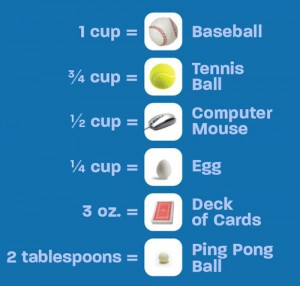I hate counting calories. I know you do, too. And the only scale I use is the kind you step on. I don’t have the patience to be meticulous about nutrition, but with summer coming up and plenty of opportunities to wear T-shirts, and sometimes much less, we need to be a little more particular about our diets than we were all winter.
Fortunately, nutrition science isn’t rocket science. We don’t need to be precise with it—only consistent. If you know how to eyeball portion sizes and what the approximate macros are in the foods you’re eating, you’re going to do fine gaining muscle with minimal fat or losing fat while retaining muscle.
I’ve created sort of a nutrition database that I hope you’ll refer to when needed. I’ve ballparked the macros for a bunch of common foods I expect you like to eat (or that you should be eating if you want to see positive changes in your body), and gave you practical measurement tools to use. Using the size of your hands and thumbs as a gauge makes determining amounts a lot easier. That is, unless you have hooks in their place.
Just make sure you’re eating food that’s as close to its natural state as possible. If you’re out to eat or picking up from a deli, beware of sauces or dressings that contain sugar or fat and can throw off your numbers. If you stick with lightly seasoned whole foods, these numbers will work, whether you’re cooking at home or getting by at a buffet.
Foods and Macros
Note that I’m dealing with macros here. It’s a lot easier to count them up than to worry about macros AND calories. So figure out how many calories you need to eat to gain muscle or lose fat beforehand and then break them down into how many grams of protein, carbs, and fat you need daily.
I didn’t bother counting the lesser nutrients in foods that are known for offering primarily one kind. For instance, nut butters have a fair number of carbs in them, but unless you’re following an ultra-low carb diet (like Carb Back-loading), you don’t need to worry about them. They don’t cause spikes in blood sugar, inhibiting your body from burning fat.
By the same token, nut butters pack a lot of protein, but I’m not counting that either because it’s not complete. If you’re a vegetarian or vegan, food combining is essential so that you get complete proteins, but for the rest of us who rely on meat for our protein, we don’t need to be concerned about these incomplete sources, and a little extra protein isn’t going to slow anybody’s progress anyway.
All numbers are rounded to make calculations easier. Relax—they don’t have to be accurate to the last gram. It’s the portion sizes that matter most. Stay consistent with them and you’ll eat very close to the same amount of calories and macros every day and see the gains you’re after.
Meats
Measure these 3 ounces at a time. Any meat or fish, from steak to salmon, is going to be about the size of your palm in both circumference and thickness (wait, we’re talking about food here, right??) when it weighs 3 ounces. You’ve probably also heard that a deck of cards makes a good approximation.
Most meats have around 20 grams of protein for 3 ounces and their fat content will hover around five grams. The exception to this lies mainly with beef, as the fat content can vary quite a bit depending on how lean the cut is or cow was. For the leanest and healthiest beef possible, get grass-fed whenever possible.
Skinless turkey breast = 20g Protein
Skinless Chicken breast = 25g Protein, 3g Fat
Pork tenderloin = 20g Protein, 3g Fat
1 chicken drumstick* = 15g Protein, 5g Fat
*Contrary to popular opinion, low-fat white meat isn’t the only way to go when eating chicken. If you’re doing a low-carb diet, fattier cuts like drumsticks are fine to keep you satiated and make sure your calories don’t dip too low.
Salmon = 20g Protein, 5g Fat
Tuna = 20g Protein, 4g Fat
Grass-fed sirloin steak = 20g Protein, 3g Fat
*Other lean cuts of steak are similar
Grass-fed ground beef = 20g Protein, 10g Fat
Conventional ground beef, 80% lean = 20g Protein, 15g Fat
Conventional sirloin, 20g Protein, 10g Fat
1 large egg = 6g Protein, 5g Fat
1 cup low-fat cottage cheese = 30g Protein, 5–10g Carbs, 5g Fat
1 cup non-fat Greek yogurt = 20g Protein, 10g Carbs
Starches
Measure these in cups, which are about the size of your fist, or a baseball.
1 cup white rice (cooked) = 45g Carbs
1 cup sweet potato = 40g Carbs
1 cup red skin potato = 40g Carbs
1 cup white potato = 40g Carbs
1 cup oatmeal (cooked) = 25g Carbs
1 slice sprouted whole grain bread = 15g Carbs
1 cup quinoa (cooked) = 40g Carbs, 10g Protein, 5g Fat
1 cup buckwheat (cooked) = 30g Carbs, 5g Protein
*Buckwheat has complete protein so you can count it
Fruit
1 large banana = 30g Carbs
1 cup mango = 30g Carbs
1 cup mixed berries = 15g Carbs
1 cup sliced avocado = 20g Fat
1 cup orange (in sections) = 20g Carbs
1 medium apple = 25g Carbs
Nuts/legumes
You can measure tablespoons with your thumb. 2 tbsp should come out to about the length of it.
1 cup almonds = 70g Fat
1 cup peanuts = 70g Fat
2 tbsp almond butter = 20g Fat
2 tbsp chunky peanut butter = 15g Fat
1 cup cashews = 180g Fat
Oils
I think you should avoid most oils except coconut oil and red palm oil, which you can do some cooking in. Olive oil can be used on salads or added to shakes. One tablespoon of any oil is going to be about 15g of fat.
No Veggies?!
Vegetables are a “free” food. Eat as many as you like and probably more than you’d care for. Only starchy veggies—root vegetables—like sweet potatoes should be counted. Celery, broccoli, Brussels sprouts, red bell peppers… go to town on them.
Condiments
As I said for dressings and sauces, use these sparingly and minimize them when you’re eating food prepared by somebody else. Salsa, salt, pepper, lemon juice, and various herbs and spices are the seasonings you should rely on, and you don’t need to measure those.
Measurement Key
1 cup = fist or baseball
3 oz meat = palm of your hand, a deck of cards
2 tbsp = length of your thumb



Join the Discussion
Related Content